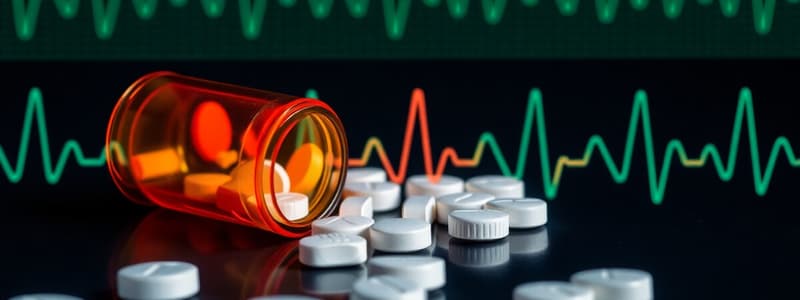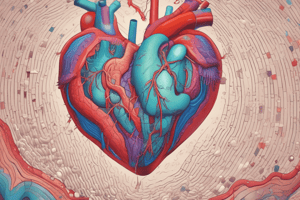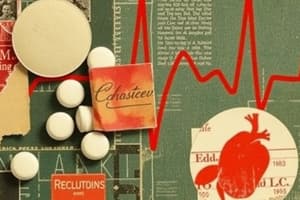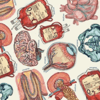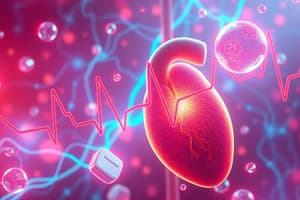Podcast
Questions and Answers
In a patient experiencing an acute angina attack, which form of nitrate administration would provide the most immediate symptom relief?
In a patient experiencing an acute angina attack, which form of nitrate administration would provide the most immediate symptom relief?
- Sublingual spray (correct)
- Intravenous infusion
- Oral tablet
- Topical-transdermal patch
A patient reports a tingling sensation when taking sublingual nitroglycerin. What is the MOST appropriate response?
A patient reports a tingling sensation when taking sublingual nitroglycerin. What is the MOST appropriate response?
- Inform the patient that this is a sign of a potential allergic reaction.
- Instruct the patient to chew the tablet for faster absorption.
- Advise the patient to discontinue use and consult their provider.
- Reassure the patient that this indicates the drug is active. (correct)
Following the administration of the first dose of sublingual nitroglycerin, a patient continues to experience angina symptoms. After how many minutes should the second dose be administered?
Following the administration of the first dose of sublingual nitroglycerin, a patient continues to experience angina symptoms. After how many minutes should the second dose be administered?
- 1 minute
- 5 minutes (correct)
- 3 minutes
- 10 minutes
Why is aspirin administered to a patient when a cardiac event is suspected?
Why is aspirin administered to a patient when a cardiac event is suspected?
Which antiplatelet medication is MOST reliant on the CYP2C19 enzyme for activation?
Which antiplatelet medication is MOST reliant on the CYP2C19 enzyme for activation?
Unlike clopidogrel, ticagrelor binds reversibly to ADP receptors, what is the therapeutic implication of this difference?
Unlike clopidogrel, ticagrelor binds reversibly to ADP receptors, what is the therapeutic implication of this difference?
What is the PRIMARY reason LMWH is favored over unfractionated heparin in many clinical situations?
What is the PRIMARY reason LMWH is favored over unfractionated heparin in many clinical situations?
Which laboratory value is essential to monitor in patients taking warfarin to ensure therapeutic anticoagulation?
Which laboratory value is essential to monitor in patients taking warfarin to ensure therapeutic anticoagulation?
Why is maintaining a stable intake of vitamin K-containing foods important for patients taking warfarin?
Why is maintaining a stable intake of vitamin K-containing foods important for patients taking warfarin?
Why does the Beers List advise caution when prescribing dabigatran in older adults?
Why does the Beers List advise caution when prescribing dabigatran in older adults?
What is the mechanism of action (MOA) by which fibrinolytics work to break down existing blood clots?
What is the mechanism of action (MOA) by which fibrinolytics work to break down existing blood clots?
A physical therapist is reviewing the chart of a patient taking antithrombotic medications. What findings would warrant IMMEDIATE consultation with the prescribing physician?
A physical therapist is reviewing the chart of a patient taking antithrombotic medications. What findings would warrant IMMEDIATE consultation with the prescribing physician?
Which of the following statements BEST reflects the overall goal of managing lipoprotein levels in atherosclerosis?
Which of the following statements BEST reflects the overall goal of managing lipoprotein levels in atherosclerosis?
What is the PRIMARY mechanism of action by which statins exert their lipid-lowering effects?
What is the PRIMARY mechanism of action by which statins exert their lipid-lowering effects?
Why should clinicians be aware of potential drug interactions and altered pharmacokinetics when a patient is taking statins?
Why should clinicians be aware of potential drug interactions and altered pharmacokinetics when a patient is taking statins?
According to the Beers List, what is the MOST important consideration when prescribing antiarrhythmics to older adult patients?
According to the Beers List, what is the MOST important consideration when prescribing antiarrhythmics to older adult patients?
What distinguishes amiodarone from other antiarrhythmic medications?
What distinguishes amiodarone from other antiarrhythmic medications?
What is the MOST critical consideration when selecting anti-dysrhythmic agents for a patient?
What is the MOST critical consideration when selecting anti-dysrhythmic agents for a patient?
A patient taking statins reports muscle pain and weakness. Which lab value would be MOST important to monitor to assess for potential myopathy or rhabdomyolysis?
A patient taking statins reports muscle pain and weakness. Which lab value would be MOST important to monitor to assess for potential myopathy or rhabdomyolysis?
Why is it important to educate patients taking anti-dysrhythmic agents about the potential for exercise intolerance?
Why is it important to educate patients taking anti-dysrhythmic agents about the potential for exercise intolerance?
Why should clinicians advise against abrupt cessation of statin therapy without medical supervision?
Why should clinicians advise against abrupt cessation of statin therapy without medical supervision?
A patient taking amiodarone is scheduled to start physical therapy. What signs and symptoms should the physical therapist monitor closely due to the drug's potential side effects?
A patient taking amiodarone is scheduled to start physical therapy. What signs and symptoms should the physical therapist monitor closely due to the drug's potential side effects?
Following a cardiac event resulting in the placement of a coronary stent, a patient is prescribed clopidogrel. What is the PRIMARY reason for this medication?
Following a cardiac event resulting in the placement of a coronary stent, a patient is prescribed clopidogrel. What is the PRIMARY reason for this medication?
A patient with a history of atrial fibrillation is prescribed warfarin. What is the MOST likely therapeutic goal regarding their INR range?
A patient with a history of atrial fibrillation is prescribed warfarin. What is the MOST likely therapeutic goal regarding their INR range?
Which of the following is the PRIMARY mechanism by which nitrates relieve angina symptoms?
Which of the following is the PRIMARY mechanism by which nitrates relieve angina symptoms?
A patient reports taking sublingual nitroglycerin prior to physical therapy sessions. What is the MAIN reason for this?
A patient reports taking sublingual nitroglycerin prior to physical therapy sessions. What is the MAIN reason for this?
Which of the following medications is classified as a Vitamin K antagonist?
Which of the following medications is classified as a Vitamin K antagonist?
Why is it important to ask patients about their intake of grapefruit juice, if they are on cardiovascular medications?
Why is it important to ask patients about their intake of grapefruit juice, if they are on cardiovascular medications?
A patient taking warfarin has an INR of 1.2. What risk is the patient MOST susceptible to?
A patient taking warfarin has an INR of 1.2. What risk is the patient MOST susceptible to?
A patient with a known history of venous thromboembolism (VTE) is prescribed enoxaparin (Lovenox) following hip replacement surgery. What is the PRIMARY goal of this medication in this scenario?
A patient with a known history of venous thromboembolism (VTE) is prescribed enoxaparin (Lovenox) following hip replacement surgery. What is the PRIMARY goal of this medication in this scenario?
When is it MOST appropriate to administer fibrinolytics
When is it MOST appropriate to administer fibrinolytics
A patient has a-fib and takes Warfarin. During a physical therapy session, the patient bumps their head. What action is MOST important for the physical therapist to take?
A patient has a-fib and takes Warfarin. During a physical therapy session, the patient bumps their head. What action is MOST important for the physical therapist to take?
What patient education would you provide regarding nitroglycerine?
What patient education would you provide regarding nitroglycerine?
Which medication is contradicted for PT treatment?
Which medication is contradicted for PT treatment?
Genetic variations in CYP2C9 and VKORC1 can lead to what?
Genetic variations in CYP2C9 and VKORC1 can lead to what?
A patient reports taking fish oil. What is a fish oil classified as?
A patient reports taking fish oil. What is a fish oil classified as?
What is a common side effect of statin medications?
What is a common side effect of statin medications?
Flashcards
Nitrates: Mechanism of Action
Nitrates: Mechanism of Action
Relax smooth muscle in blood vessels, decreasing preload and afterload, reducing heart workload and O2 demand.
Nitrates
Nitrates
Work directly on vascular smooth muscle instead of through a receptor, causes relaxation within blood vessels.
Sublingual Nitroglycerine: Key Points
Sublingual Nitroglycerine: Key Points
Limit light exposure, short shelf life, tingling sensation indicates drug is active, follow dosing instructions.
Anti-thrombotics
Anti-thrombotics
Signup and view all the flashcards
Antiplatelets
Antiplatelets
Signup and view all the flashcards
Anticoagulants
Anticoagulants
Signup and view all the flashcards
Fibrinolytics
Fibrinolytics
Signup and view all the flashcards
What is Aspirin's MOA?
What is Aspirin's MOA?
Signup and view all the flashcards
ADP Receptor Inhibitors MOA
ADP Receptor Inhibitors MOA
Signup and view all the flashcards
Dabigatran (Pradaxa) MOA
Dabigatran (Pradaxa) MOA
Signup and view all the flashcards
Factor Xa Inhibitors MOA
Factor Xa Inhibitors MOA
Signup and view all the flashcards
Fibrinolytics MOA
Fibrinolytics MOA
Signup and view all the flashcards
Common statin side effects
Common statin side effects
Signup and view all the flashcards
Statins: Mechanism of Action
Statins: Mechanism of Action
Signup and view all the flashcards
Arrhythmias
Arrhythmias
Signup and view all the flashcards
Amiodarone MOA
Amiodarone MOA
Signup and view all the flashcards
Arrhythmia or dysrhythmia
Arrhythmia or dysrhythmia
Signup and view all the flashcards
Monitor Bleeding
Monitor Bleeding
Signup and view all the flashcards
Nitrates
Nitrates
Signup and view all the flashcards
Anti-thrombotics
Anti-thrombotics
Signup and view all the flashcards
Anticoagulants
Anticoagulants
Signup and view all the flashcards
Vitamin K Antagonist (VKA)
Vitamin K Antagonist (VKA)
Signup and view all the flashcards
Statins adverse effects
Statins adverse effects
Signup and view all the flashcards
Study Notes
Cardiovascular Medications
- Learning objectives involve identifying indications, mechanisms of action (MOA), adverse events, and therapeutic considerations for various cardiovascular medications.
Cardiac Medications
- Medications can be categorized as nitrates, anti-thrombotics, statins, and anti-arrhythmics.
- Nitrates are used for ischemic conditions like angina and myocardial infarction (MI).
- Anti-thrombotics, including antiplatelets and anticoagulants, prevent clot formation in conditions like atrial fibrillation, MI, cerebrovascular accident (CVA), deep vein thrombosis (DVT), and pulmonary embolism (PE).
- Fibrinolytics are "clot busters" used in CVA.
- Statins reduce cholesterol and treat atherosclerosis.
- Anti-arrhythmics treat heart arrhythmias.
Angina Treatment Options
- Common drugs for angina pectoris treatment include vasodilators (nitrates, calcium blockers) and cardiac depressants (beta-blockers).
Nitrates
- Nitrates directly act on vascular smooth muscle, leading to relaxation of blood vessels and vasodilation.
- They reduce preload and afterload, decreasing the heart's workload and oxygen demand.
- Nitrate forms include IV, sublingual spray, chewable tablets, oral tablets, and topical transdermal patches.
- Sublingual nitrates are the drug of choice for acute angina attacks, providing immediate symptom relief.
About Sublingual Nitroglycerine
- Sublingual nitroglycerin should be stored in a glass brown bottle to limit light exposure.
- It has a short shelf life of 6 months if unopened, and 3 months once opened.
- A tingling sensation indicates that the drug is active.
- After the first dose, relief should occur within 1-2 minutes.
- A second dose can be taken if symptoms persist after 5 minutes, up to 3 doses in 15 minutes.
- Lack of relief may indicate a possible MI.
- Adverse effects (AE) include reflex tachycardia, dizziness, orthostatic hypotension (OH), and weakness.
Management of Unstable Angina/MI
- When a cardiac event is suspected, immediately chew 325 mg of non-enteric coated aspirin.
- Up to 3 doses of nitroglycerin can be administered over 15 minutes and IV nitroglycerin may be started in the emergency department (ED).
- ECG determines the type of cardiac event (STEMI vs NSTEMI).
- STEMI (ST segment elevation MI) treatment includes a thrombolytic agent, aspirin, nitrates, and beta-blockers.
- Clopidogrel, GP IIb/IIIa inhibitors, and LMWH may also be given.
- NSTEMI (non-ST segment elevation MI) treatment involves heparin instead of thrombolytics.
Antithrombotics
- Antiplatelets prevent thrombus formation, including aspirin and ADP receptor inhibitors.
- Anticoagulants prevent initial thrombus formation and extension of existing thrombi.
- Parenteral anticoagulants include heparin, LMWH, direct thrombin inhibitors, and fondaparinux.
- Oral anticoagulants include Vitamin K antagonists, direct thrombin inhibitors, and Factor Xa inhibitors.
- Fibrinolytics lyse active thrombi, including alteplase, tenecteplase, reteplase, urokinase, and streptokinase.
- All antithrombotics carry a risk of bleeding.
- Antithrombotic drugs target different components in thrombus formation.
- Antiplatelets target the primary component in arterial thrombosis ("white clot").
- Anticoagulants target the primary component in venous thrombosis ("red clot").
- Fibrinolytics target platelets and fibrin.
- A thrombus forms when fibrin binds platelets together.
- Fibrin is formed through a pathway that starts with collagen and von Willebrand factor involving ADP and thromboxane A2, which antiplatelet drugs act on.
- Platelet-fibrin is formed through another pathway that anticoagulation drugs act on.
Coordinated Role of Platelets and the Coagulation System in Thrombogenesis
- Vascular injury occurs, exposing collagen and von Willebrand factor (VWF).
- Platelets adhere to collagen and VWF, releasing ADP and thromboxane A2.
- ADP and thromboxane A2 recruit more platelets, which are then activated.
- Glycoprotein IIb/IIIa receptors undergo a conformational change leading to more platelet aggregation.
- Vascular injury exposes tissue factors.
- Tissue factor triggers the coagulation pathway and thrombin generation.
- Thrombin recruits more platelets and converts fibrinogen to fibrin.
- Fibrin binds platelets together to form the platelet/fibrin thrombus.
Location of Medication Impact
- Aspirin inhibits COX-1 and TXA2.
- Clopidogrel, prasugrel, ticagrelor, and cangrelor inhibit ADP.
- Vorapaxar inhibits thrombin.
- Abciximab, eptifibatide, and tirofiban inhibit GPIIb/IIIa activation.
Aspirin
- Aspirin inhibits both COX-1 and COX-2, reducing production of thromboxane A2 and inhibiting platelet aggregation.
- At low doses (81 mg), aspirin primarily inhibits COX-1 for cardiovascular protection.
ADP Receptor Inhibitors (Irreversible)
- Clopidogrel (Plavix) and prasugrel (Effient) are irreversible ADP receptor inhibitors.
- The active metabolite irreversibly blocks ADP receptor binding, decreasing platelet aggregation for the platelet's lifespan (7-10 days).
- They are used after acute coronary syndrome (ACS) with percutaneous coronary intervention (PCI) and stroke.
- ACS includes NSTEMI, STEMI, and unstable angina (UA); PCI is a percutaneous coronary intervention.
- ADP receptor inhibitors are generally well-tolerated, but bleeding is a major concern, requiring monitoring of symptoms and labs (Hgb/Hct).
- Focus is on clopidogrel (Plavix).
- Metabolism involves CYP2C19 to active metabolite.
- Boxed warnings indicate decreased efficacy in some genetic variants with CYP2C19 poor metabolizers (present in 50% of Asians, 30% of African-Americans, and 25% of Caucasians).
ADP Receptor Inhibitors (Reversible)
- Ticagrelor (Brilinta) is a reversible inhibitor.
- It reversibly binds the ADP receptor on the platelet surface, decreasing platelet aggregation.
- It is used for ACS (up to 1 year or more after MI).
Anticoagulants
- Parenteral anticoagulants include heparin and low-molecular weight heparin (LMWH) like enoxaparin (Lovenox).
- Oral anticoagulants (PO) include vitamin K antagonists like warfarin (Coumadin), direct thrombin inhibitors like dabigatran (Pradaxa), and Factor Xa inhibitors like rivaroxaban (Xarelto) and apixaban (Eliquis).
- Direct oral anticoagulants (DOACs) are all renally eliminated.
Simplified Coagulation Cascade
- Fibrin acts as a "mesh" to create a clot and must be converted from fibrinogen.
- Tissue factor (TF) is exposed after injury.
- TF along with activated factors (F) VIIa, IXa, Xa, VIIIa, and Va convert prothrombin to thrombin (factor IIa).
- Thrombin (FIIa) then converts fibrinogen to fibrin.
Heparin
- Heparin can be administered IV or subcutaneously.
- It potentiates the action of antithrombin, inactivating thrombin and factors FIXa, FXa, FXIa, FXIIa, which prevents the conversion of fibrinogen to fibrin.
- Treatment doses require monitoring of aPTT levels.
- Heparin-induced thrombocytopenia (HIT) occurs when the body creates antibodies that bind to heparin on the platelet surface, activating platelets, causing clotting, and lowering platelet levels.
- It is treated with direct thrombin inhibitors or Factor Xa inhibitors.
LMWH
- LMWH can be administered IV or subutaneously, including enoxaparin (Lovenox), tinzaparin (Innohep), and dalteparin (Fragmin).
- Like heparin, LMWH potentiates the action of antithrombin but has a greater effect on inhibiting FXa than thrombin.
- It is preferred over heparin because of more simple dosing, no monitoring required, and a lower risk of HIT.
Warfarin-Vitamin K Antagonist (VKA)
- Warfarin (Coumadin) is administered orally.
- Active vitamin K is required for the synthesis of factors VII, IX, X, and II, and proteins C and S.
- Warfarin binds to VKORC1, an enzyme that converts inactive vitamin K to active vitamin K, leading to depletion of vitamin K stores, thus inhibiting the synthesis of factors VII, IX, X, and II.
- Warfarin does not have an immediate effect, requiring 3-5 days for full effect and longer to stabilize the dose.
- Doses may be frequently changed and even vary based on the day of the week.
- As a narrow therapeutic index (NTI) drug, requires frequent monitoring of international normalized ratio (INR; normal ~1).
- An INR of 2-3 is needed for atrial fibrillation (AF) or venous thromboembolism (VTE).
- An INR of 2.5-3.5 is needed for mechanical heart valves.
- If INR is low, the patient is at risk for increased clot formation.
- Effects are metabolized by CYP2C9; genetic variants of CYP2C9 and VKORC1 can increase bleeding risk unless the dose is adjusted.
- It has many drug interactions and food interactions and important to maintain a stable intake of Vitamin K containing food.
Direct Thrombin Inhibitors
- Dabigatran (Pradaxa) is an oral direct thrombin inhibitor.
- It binds directly and reversibly to thrombin with high selectivity, inhibiting the conversion of fibrinogen to fibrin.
- There is less intracranial bleeding compared to warfarin, but more GI bleeding; high risk of GI bleeding in people over 75 years old.
- Other adverse effects include dyspepsia (10%), which can be minimized by taking it with food.
Factor Xa Inhibitors
- Rivaroxaban (Xarelto) and apixaban (Eliquis) are oral Factor Xa inhibitors
- Selectively and reversibly bind FXa stopping further coagulation cascade
- There is less intracranial bleeding than warfarin but rivaroxaban has more gi bleed.
- All DOACs : shorter duration of action than warfarin so less preferred if the patient is not compliant but is more convenient when needing to hold it before a procedure.
Monitoring with Antiplatelets and AntiThrombotics
- BLEEDING:
- Bleeding around gums when brushing teeth.
- Black, tarry stool. -Blood in urine. -Some bruising expected but excessive bruising that lingers.
- Seek medicine help if nosebleed or a cut won't stop bleeding.
- Seek medicine help if hit head during a fall.
- CLOTTING:
- Red, swollen, warm extremity, usually unilateral and in calf.
- SOB, chest pain, cough.
Fibrinolytics(AKA-thrombolytics)
- Clot-busters: alteplase, tenecteplase, reteplase, urokinase, streptokinase are most commonly administered through IV.
- MOA
- Mimic endogenous tissue plasminogen activator (TPA) converts plasminogen to plasmin= plasmin breaks fibrin links in the thrombus and used to treat after stroke, MI PE
Therapeutic Concerns about Anti-thrombotic Drugs
- FALLS: Even an "easy" fall could cause significant interal bleeding.
- PT treatments: Debridement, techniques, DTM/percussion CONTRAINDICATED.
- Observe for: Nosebleeds, bruising, pain in back, abdomen, joints (internal bleeding).
- Heparin and warfarin vs LMWH are more high risk:
- lab values need to be considered: PT PTT, aPTT and INR
- aF/DVT/PE 2.0-3 greater risk of bleeding
Atherosclerotic Medications
- Atherosclerosis is a narrowing and hardening of the arteries.
- Atherosclerosis is when lipoproteins in the blood are made of triglycerides and cholesterols and are made of VLDL, LDL, HDL
- In simplified terms low LDL's are good( less likely to oxidize and form plaques) and high HDL is good) takes up LDL from peripheral tissues and transports back to the liver.
- Goal is to reduce risk of MI and stroke
Statins
- Statins block HMG-COA reductase which blocks cholesterol synthesis
- Common AE: myaligia
- Large proximal muscle group
- Likely with lower doses
- Likely with pravastatin, rosuvastatin because more hydrophilic
- Likely in elderly female, low BMI, Asian descent, excess alcohol, high levels physical activity and trauma, and combo with interacting meds
- Myopathy/rhabdomyolisis is rare - more risk with drug-drug interactions(Especially fibrates)
- Large proximal muscle group
- Myositis/Myalgia presents with muscle pain, fatigue/ weakness, creatinine kinase (Ck) > 10 times upper normal limit.
- Persists muscle effects/ degree to which statins unmask vs induce muscle disease is unclear. Exacerbates known muscle conditions (1.e M.G).
Therapeutic Concerns with Statins
- Grapefruit juice inhibits CYP3A4 that is linked to statin rhabdomyolysis
- There's also a CYP3A4 competition for common metabolic pathway which means polypharmacy increases competition which increases statin concentration= dose - related statin AE
- If CYP3A4 inhibits- 6 fold increase associated with hospitalizations with myopathy from rhabdomyolysis in pt with lipid therapy.
- Liver/Kidney function can affect pharmacokinetics= Differences in CYP pathways leads to altered pharmacokinetics
Arrhythmia and Antiarrhythmic Medications
- Arrythmia or dysrhythmia- disturbance of heart rate or rhythm to an abnormal rate of impulse from the SA node/abnormal conduction of impulses.
- Classified by origin: Ventricular or atrial(supraventricular); Pattern Fibrillation/ flutter
Cardiac Arrythmias: Disturbance of Rate or Rhythm
- Sinoatrial node = responsible for regulating the number of heart beats/rhythm
Studying That Suits You
Use AI to generate personalized quizzes and flashcards to suit your learning preferences.
